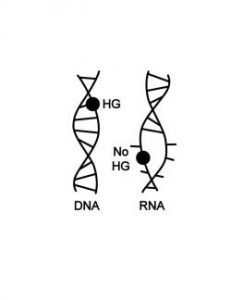Puzzle of “Why DNA and not RNA is the blueprint of life” solved | Time to rewrite the textbooks
While DNA has had its fill of fame in contemporary biology, the RNA concept retains its once-glorious reputation only in the sides as being the origin of prehistoric life. Once when the earliest organisms were yet to multiply in an alien planet, their RNA structures would help them self-replicate. Thus, mating was an unknown concept then.
But evolution jumpstarted and things swerved from left to right. Mating is now the main avenue for reproduction. And with reproduction, the DNA won the bid, owning the sole responsibility of encoding the human genetic information.
Meanwhile, in front of a buzzing crowd of academics and regular personalities, Hashim-Al-Hashimi of Duke University presents his latest findings.Found in the journal Nature Structure and Molecular Biology are Hashimi’s profound reflections on why and how humans evolved with the DNA and not the RNA.
Before the crowd could respond, Hashimi announces that by looking into the littlest details of the DNA’s double helix using a Nuclear Magnetic Resonance (MNR), he was able to detect a unique characteristic of the DNA that is not found in the RNA- the
ability to change shapes.It was way back in 1953 that the model of DNA double helix was published by its creator, Watson and Crick, who also predicted how the base pairs, A & T and G & C, fit together.
Two strands of DNA are linked by the bonding of the base pairs, forming ladder rungs that hold together the twisted ladder of DNA. The researchers, however, faced a tough time in looking for evidence that the base pairs were bonding in the way that Watson and Crick had predicted.
Six years later in 1959, biochemist Karst Hoogsteen was able to click a picture of an A–T base pair, showing a slightly more skewed geometry, with one base rotated 180 degrees relative to the other. Ever since, researchers have observed both Watson-Crick and Hoogsteen base pairs in images of DNA.
The secret of the DNA’s victory lies on that Hoogsteen base pair. With the help of Hoogsteen’s precepts and the Watson-Crick’s physical musings on the nucleic acid connection, Hashimi was able to describe the continuous shifting between the two forms in the base pairs, five years ago.
That discovery was a big deal in itself, but now the team has shown for the first time that RNA doesn’t have this ability, which could explain something that scientists have puzzled over for years: why DNA forms the blueprint for life, not RNA.
Hashimi was also able to note that with such instability of the DNA’s spiral staircase, one of the nucleic acids gets upturned 180 degrees, causing the entire double helix foundation to collapse.The DNA is a very dynamic entity. It can shape and reshape whenever it wants to. This characteristic is by all means, the sole cause we appear how we appear today, stated Hashimi.
So, while DNA will absorb chemical damage and adapt to work around it, RNA becomes too stiff and falls apart, making DNA the better structure to pass genetic information down between the generations.
“In DNA this modification is a form of damage, and it can readily be absorbed by flipping the base and forming a Hoogsteen base pair. In contrast, the same modification severely disrupts the double helical structure of RNA,” said one of the team, Huiqing Zhou.
“The finding will likely rewrite textbook coverage of the difference between the two purveyors of genetic information, DNA and RNA,” said a Duke Universitypress release.
You can see DNA on the left performing Hoogsteen bonding to incorporate damaged base-pairs, while RNA on the right falls apart:

The team explains that this is because the RNA double helical structure is more packed together compared to DNA, and because of that, one RNA base can’t change direction without hitting another one or shifting atoms, and ripping the whole structure apart.
“There is an amazing complexity built into these simple beautiful structures, whole new layers or dimensions that we have been blinded to because we didn’t have the tools to see them, until now,” said Al-Hashimi.
Further research is needed to test the hypothesis that it’s this flexibility of DNA, and not RNA, that led to DNA becoming the blueprint of life, but if confirmed, it could help us understand why life on Earth evolved to be the way it is.
The press release from the Duke University can be found here.





























